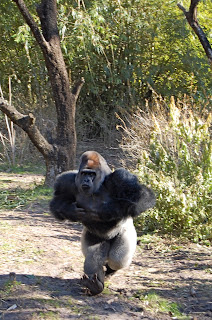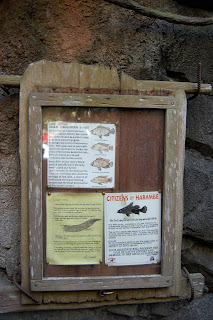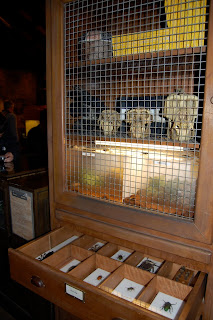Returning into the Pangani Forest, we come upon an open-sided shack which is a base of operations for researchers studying gorillas in the area. One whole side of the shack has been glassed in to allow up close observation. During the day, a primatologist named Mirza works out of this outpost, studying gorilla nutrition interactions.
The outpost is also set up for overnight monitoring and recording of gorilla behavior. The two researchers engaged in this work are Stephanie Lukas, an American student working in Harambe, and Ruth Kimutai, a Tanzanian. During the night, they work in shifts, taking turns sleeping. Peek through the mosquito netting on their bunks, and it's easy to tell who sleeps on top and bottom. Ruth lives far more simply, with far less personal gear than Stephanie seems to require.
Just as we've seen throughout the Pangani Forest School, research notes and other documentation can be found here, sharing information with Guests. The large chalkboard in the corner is left over from Dr. Kulunda's recent lecture on gorilla anatomy.
Next to Stephanie Lukas's note to Ruth (above) is a map of the region, marking a natural boundary between two troops of gorillas. As we leave the outpost and cross a suspension bridge into the valley, we suddenly find ourselves right in the middle.
On one side of us is a family troop. A troop of bachelor males resides on the other (gorillas are patriarchal, where one dominant male will often have multiple females in his troop, leaving other males out of the mating game). The boundary of the stream prevents the territories of these troops from overlapping, but that doesn't mean there aren't occasional expressions of dominance, just to show the others who's boss.
The Pangani Forest Conservation School and Wildlife Sanctuary is an incredible place where important research work is being done and the citizens of Harambe can make a vital connection with the animals that share their world.
A bit of Hidden Disney: Remember the Swahili reference to the original attraction name back at the entrance to Pangani Forest? Well, here's the one place where the name remains in English. This crate (above) in the area of the gorilla observation outpost still carries the label for Gorilla Falls Conservation School. Since the crate is made of wood, though, it's a detail that isn't likely to last forever.














































